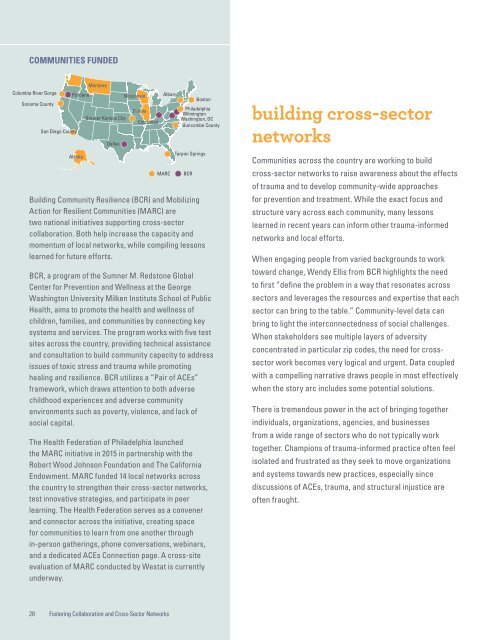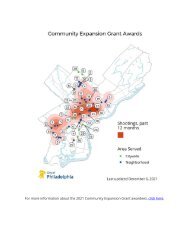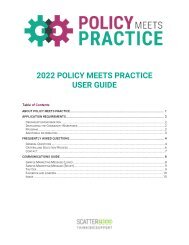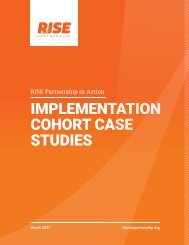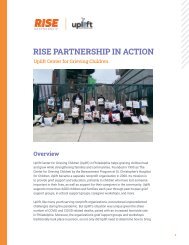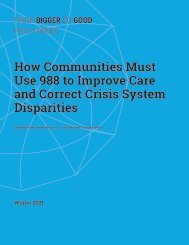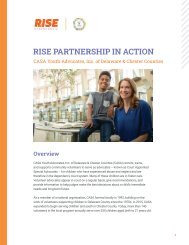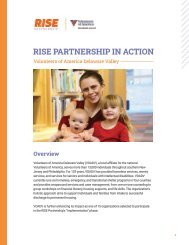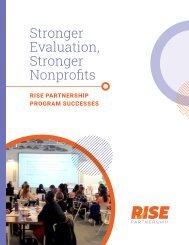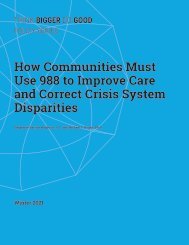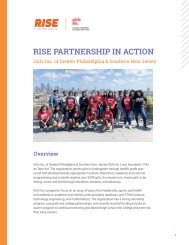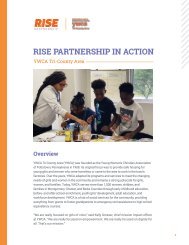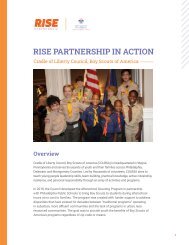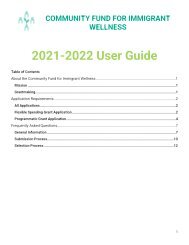Trauma-Informed Philanthropy Vol2
You also want an ePaper? Increase the reach of your titles
YUMPU automatically turns print PDFs into web optimized ePapers that Google loves.
Lorem ipsum<br />
COMMUNITIES FUNDED<br />
Columbia River Gorge<br />
rmation<br />
es<br />
city<br />
Sonoma County<br />
San Diego County<br />
Portland<br />
Alaska<br />
Montana<br />
Greater Kansas City<br />
Dallas<br />
Wisconsin<br />
Illinois<br />
Cincinnati<br />
Albany<br />
MARC<br />
Boston<br />
Philadelphia<br />
Wilmington<br />
Washington, DC<br />
Buncombe County<br />
Tarpon Springs<br />
Building Community Resilience (BCR) and Mobilizing<br />
Action for Resilient Communities (MARC) are<br />
two national initiatives supporting cross-sector<br />
collaboration. Both help increase the capacity and<br />
momentum of local networks, while compiling lessons<br />
learned for future efforts.<br />
BCR, a program of the Sumner M. Redstone Global<br />
Center for Prevention and Wellness at the George<br />
Washington University Milken Institute School of Public<br />
Health, aims to promote the health and wellness of<br />
children, families, and communities by connecting key<br />
systems and services. The program works with five test<br />
sites across the country, providing technical assistance<br />
and consultation to build community capacity to address<br />
issues of toxic stress and trauma while promoting<br />
healing and resilience. BCR utilizes a “Pair of ACEs”<br />
framework, which draws attention to both adverse<br />
childhood experiences and adverse community<br />
environments such as poverty, violence, and lack of<br />
social capital.<br />
The Health Federation of Philadelphia launched<br />
the MARC initiative in 2015 in partnership with the<br />
Robert Wood Johnson Foundation and The California<br />
Endowment. MARC funded 14 local networks across<br />
the country to strengthen their cross-sector networks,<br />
test innovative strategies, and participate in peer<br />
learning. The Health Federation serves as a convener<br />
and connector across the initiative, creating space<br />
for communities to learn from one another through<br />
in-person gatherings, phone conversations, webinars,<br />
and a dedicated ACEs Connection page. A cross-site<br />
evaluation<br />
Engage<br />
of MARC conducted by Westat is currently<br />
underway. Stakeholders<br />
BCR<br />
networking coordinating cooperating collaborating<br />
x x x x<br />
x x x<br />
x<br />
building cross-sector<br />
networks<br />
Communities across the country are working to build<br />
cross-sector networks to raise awareness about the effects<br />
of trauma and to develop community-wide approaches<br />
for prevention and treatment. While the exact focus and<br />
structure vary across each community, many lessons<br />
learned in recent years can inform other trauma-informed<br />
networks and local efforts.<br />
When engaging people from varied backgrounds to work<br />
toward change, Wendy Ellis from BCR highlights the need<br />
to first “define the problem in a way that resonates across<br />
sectors and leverages the resources and expertise that each<br />
sector can bring to the table.” Community-level data can<br />
bring to light the interconnectedness of social challenges.<br />
When stakeholders see multiple layers of adversity<br />
concentrated in particular zip codes, the need for crosssector<br />
work becomes very logical and urgent. Data coupled<br />
with a compelling narrative draws people in most effectively<br />
when the story arc includes some potential solutions.<br />
There is tremendous power in the act of bringing together<br />
individuals, organizations, agencies, and businesses<br />
from a wide range of sectors who do not typically work<br />
together. Champions of trauma-informed practice often feel<br />
isolated and frustrated as they seek to move organizations<br />
and systems towards new practices, especially since<br />
discussions of xACEs, trauma, and structural injustice are<br />
often fraught.<br />
x<br />
e Use and<br />
Lessons<br />
Describe<br />
the Program<br />
28 Fostering Collaboration and Cross-Sector Networks


